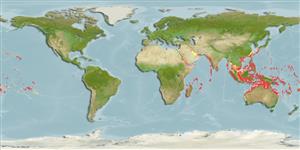Common names from other countries
Environment: milieu / climate zone / depth range / distribution range
экология
морской ассоциированный с рифами; пределы глубины 0 - 90 m (Ref. 128797), usually 10 - ? m (Ref. 1602). Tropical; 30°N - 32°S, 29°E - 130°W
Indo-Pacific: Red Sea and East Africa (south to Coffee Bay, South Africa, Ref. 5372) to the Hawaiian Islands and Samoa, north to southern Japan, south to New South Wales, Australia and New Caledonia. Eastern Pacific: Galapagos Islands (Ref. 5227).
Size / Вес / Возраст
Maturity: Lm ? range ? - ? cm
Max length : 15.0 cm TL самец/пол неопределен; (Ref. 5372)
колючие лучи спинного плавника (общее число) : 13 - 14; членистые (мягкие) лучи спинного плавника (общее число) : 20 - 23; колючие лучи анального плавника: 3; членистые (мягкие) лучи анального плавника: 17 - 20; позвонки: 24. Body is yellowish brown with two broad white vertical bars running across the body one from near the origin of the dorsal spine and the other from the middle of the back. A black bar runs vertically across the eye. There are numerous dotted horizontal stripes on the sides. The margin of caudal fin is transparent (Ref. 4855). Snout length 2.5-3.2 in HL. Body depth 1.5-1.8 in SL (Ref. 90102).
Occur in deeper lagoons and channels, and seaward reefs (Ref. 1602). Benthopelagic (Ref. 58302). Depth 2-61 m, usually below 10 m (Ref. 90102). Occur singly or in pairs (Ref. 37816). Common, omnivorous individuals that feed mainly on soft coral polyps (mainly on Sarcophyton tracheliophorum and Litophyton viridis), algae and zooplankton. Oviparous (Ref. 205). Form pairs during breeding (Ref. 205).
Life cycle and mating behavior
Maturities | размножение | Spawnings | Egg(s) | Fecundities | личинки
Distinct pairing (Ref. 205). Monogamous mating is observed as both obligate and social (Ref. 52884).
Myers, R.F., 1991. Micronesian reef fishes. Second Ed. Coral Graphics, Barrigada, Guam. 298 p. (Ref. 1602)
Статус Красного Списка МСОП (Ref. 130435)
CITES (Ref. 128078)
Not Evaluated
Угроза для людей
Harmless
Использование человеком
рыболовство: рыболовство как средство для существования; аквариум: коммерческий
дополнительная информация
инструменты
Специальные отчеты
Скачать в формате XML
ресурсы в Интернет
Estimates based on models
Preferred temperature (Ref.
115969): 24.7 - 29, mean 27.8 (based on 832 cells).
Phylogenetic diversity index (Ref.
82804): PD
50 = 0.5000 [Uniqueness, from 0.5 = low to 2.0 = high].
Bayesian length-weight: a=0.03090 (0.01881 - 0.05077), b=3.04 (2.90 - 3.18), in cm Total Length, based on LWR estimates for this species & Genus-body shape (Ref.
93245).
Trophic level (Ref.
69278): 2.9 ±0.2 se; based on diet studies.
устойчивость к внешним воздействиям (Ref.
120179): высокий, минимальное время удвоения популяции до 15 месяцев (Preliminary K or Fecundity.).
Fishing Vulnerability (Ref.
59153): Low vulnerability (10 of 100).
